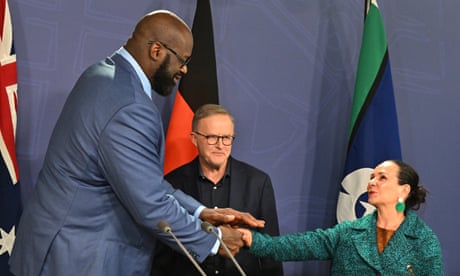- by foxnews
- 03 Apr 2025
How would an Indigenous voice work and what are people saying about it?
How would an Indigenous voice work and what are people saying about it?
- by theguardian
- 28 Aug 2022
- in news

The Albanese government has put forward a preferred form of words to insert into the constitution to enshrine an Indigenous voice to parliament, starting with a simple question for us all to vote on.
He also suggested three sentences be added to the constitution:
The PM is referring to the Indigenous voice co-design report by Professors Langton and Calma. They led a group appointed by the former Indigenous minister Ken Wyatt as part of a 2019 election promise to develop options for an Indigenous voice.
The voice would advise the Australian parliament and government on matters relating to the social, spiritual and economic wellbeing of Aboriginal and Torres Strait Islander peoples.
Parliament and government would be obliged to consult it on matters that overwhelmingly relate to Aboriginal and Torres Strait Islander peoples, such as native title, employment, housing, the Community Development Program, the NDIS or heritage protection.
The voice would be able to table formal advice in parliament, and a parliamentary committee would consider that advice. But all elements would be non-justiciable, meaning that there could not be a court challenge and no law could be invalidated based on this consultation.
The report recommended the national voice have 24 members, with gender balance structurally guaranteed.
Members would serve four-year terms, with half the membership determined every two years. There would be a limit of two consecutive terms per member.
Two co-chairs of a different gender to one another would be selected by the members of the voice every two years.
The co-design report proposed 35 regions, broken down by state and territory. Communities and governments in each state and territory would jointly determine these.
Local and regional voices would provide advice to all levels of government to influence policy and programs, and advise the non-government sector and business.
The report outlines their roles, how they would be constituted and the principles they would embody, like cultural leadership, community-led design and empowerment.
The national voice would be an advisory body to the Australian parliament and government. It would not deliver services, manage government funding, be a clearing house for research, or mediate between Aboriginal and Torres Strait Islander organisations.
The report recommended mediation in the first instance. If that failed, matters would go to an independent review. The report suggested there be an agreed list of people with appropriate experience to conduct such reviews, and at least one of the reviewers should be an Aboriginal or Torres Strait Islander person.
It suggested the final decision-maker could be the relevant minister, alongside two respected, independent Aboriginal or Torres Strait Islander people.
On 17 August, Burney met her state and territory counterparts, who agreed to continue to support a voice enshrined in the constitution.
The ministers discussed some of the practical steps for implementing voice arrangements at a regional level.
- by foxnews
- descember 09, 2016
Flight passenger says man deliberately squatted in window seat, ignites social media debate
An airline flyer said a seat squatter tried to tell her to swap seats with him, but she stood her ground, prompting a social media debate. A travel expert weighs in.
read more


